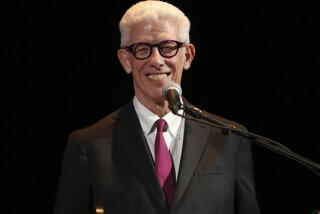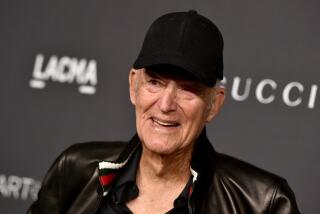Robert R. Wark, 82; former director of art collections at the Huntington Library
- Share via
Robert R. Wark, a scholar of British art who for 34 years presided over the art division of the Huntington Library, Art Collections and Botanical Gardens with uncommon erudition, wit and grace, has died. He was 82.
Wark died June 8 in Edmonton, Canada, his birthplace, after a long struggle with Alzheimer’s disease, a Huntington spokesperson said.
An enchantingly unpretentious leader with old-fashioned manners and a twinkle in his eyes, Wark personified the Huntington to many aficionados of the San Marino institution’s art collections -- best known for British “grand manner” portraits, including Thomas Gainsborough’s “The Blue Boy,” Thomas Lawrence’s “Pinkie” and Joshua Reynolds’ “Sarah Siddons as the Tragic Muse.”
Wark was a fiercely dedicated scholar who produced about 100 exhibitions, researched and wrote dozens of publications, and greatly enlarged the Huntington’s art holdings.
“Bob Wark stands for what the Huntington was, traditionally,” said Robert Skotheim, who ended his 12-year tenure as president of the Huntington in 2000. “That’s expressed by his leadership of the art collections from 1956 to 1990. For much of that period, he was really running everything himself. The standards were exemplary, the taste was exquisite. It was an extraordinary thing.
“What people saw in the galleries was, of course, [Henry E.] Huntington’s collecting, but supplemented by Bob, who was always ahead of the art market. He collected silver and prints before they became so expensive. And he did the lion’s share of the scholarship.
“People who wanted to learn about what Mr. Huntington had collected, and what others had given, read what Bob wrote about it. He also raised a good deal of money for acquisitions. The Huntington wasn’t raising money at the time, but Bob was so beloved and he was quite savvy about people who maybe would do things for the art division.”
Wark expanded the Huntington’s core holding of British paintings and spearheaded collections of British watercolors and drawings, sculpture, silver and furniture. He also expanded the institution’s geographic reach, adding French, Italian, Flemish and Dutch objects with the acquisition of the Adele S. Browning collection, and persuading the trustees to found an American art collection with a gift of 50 paintings from the Virginia Steele Scott Foundation.
To the amazement of many Huntington watchers, Wark supervised the planning and construction of the Virginia Steele Scott Gallery for American art, the establishment of a related study center and the addition of a gallery devoted to the Arts and Crafts movement in California.
John Murdoch, who serves in Wark’s former position, said that his predecessor “made this place -- made the art collections of the Huntington into a serious and functioning art museum, as Mr. Huntington had himself intended.”
Born Oct. 7, 1924, in Edmonton, Wark was the son of a Canadian grain inspector and his wife who struggled to make ends meet during the Depression. A quiet child whose intelligence was recognized early, he grew up loving music, learned to play the piano and nurtured a passion for chamber music. Occasionally, during quiet moments at the Huntington, he would play the harpsichord in the main picture gallery. He thought he was alone, but curator Shelley M. Bennett, who began working with him in 1970 and recently retired, said that secretly listening to his impromptu recitals are among her fondest memories of her mentor.
Wark studied English literature and history at the University of Alberta and became steeped in art history at Harvard University, earning a master’s degree and doctorate in British art and specializing in the Georgian period. He taught art history at Harvard and Yale universities for four years before accepting a position at the Huntington in 1956. Despite the demands of the job, he taught art history at Caltech from 1960 to 1990 and at UCLA from 1965 to 1980.
He also found considerable time to write books such as “Early British Drawings in the Huntington Collection 1700-1750,” “Ten British Pictures 1740-1840” and extensive volumes on the drawings of sculptor John Flaxman and caricaturist Thomas Rowlandson, also at the Huntington. A hefty catalog of the Huntington’s British paintings, written by Bennett and Robyn Asleson, is dedicated to Wark and builds upon his work.
“French 18th Century Art at the Huntington,” to be published in January, was written by Bennett and Carolyn Sargentson, but it was founded on Wark’s research, Bennett said.
Bennett, who worked with Wark for 20 years and has succeeded him as a senior research associate at the Huntington, said that he was a traditional connoisseur with “an astonishing visual memory and clarity of mind” that is reflected in his writing.
“ ‘Ten British Pictures,’ for example, is so straightforward,” she said. “He wrote declarative sentences in a simple presentation. Everybody can understand it immediately, but the more I learned about British art, the more I realized how subtle and layered his writing was. It’s deceptively simple writing. It’s the same way he talked. He seemed like a simple person, but he had an extraordinary mind.”
Just before his retirement in 1990, Wark told a Times interviewer that he knew the Huntington was the place for him the first time he laid eyes on it.
“I’ve never looked back despite some fairly handsome offers to move,” he said. “I’ve had an incredibly happy career getting paid for doing what I most enjoy.”
Wark had a close relationship with his sister, Kay, but her death preceded his and he has no survivors. In 1991, the siblings donated land and funds to begin construction of a lodge at a recreational facility near Edmonton for groups of elderly and disabled people. The lodge is dedicated to their parents, Joseph Henry and Louise Rodger Wark.
A memorial service for Wark will be held at 11 a.m. Wednesday at Holy Trinity Anglican Church in Edmonton.
Donations can be made, in lieu of flowers, to the Peaceful Valley Day Use Lodge, c/o Alberta Sport, Recreation, Parks and Wildlife Foundation, 905 Standard Life Centre, 10405 Jasper Ave., Edmonton, Alberta, Canada T5J 4R7
More to Read
The biggest entertainment stories
Get our big stories about Hollywood, film, television, music, arts, culture and more right in your inbox as soon as they publish.
You may occasionally receive promotional content from the Los Angeles Times.










